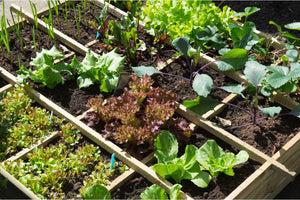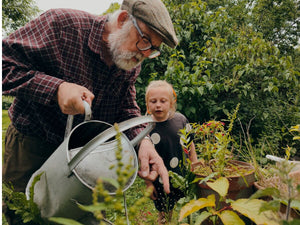The Best Vegetables for Raised Garden Beds
Types of gardensRaised garden beds are prime gardening spots! These compact spaces are where you can put your best soil, and it won’t erode or wash away. In this fertile spot, you will want to choose the best vegetables to grow in raised beds for the maximum harvest.
Read on to see our top choices for raised bed veggies.

Vegetables to Grow in Raised Garden Beds
Raised garden beds have many advantages that make them worth the initial investment. Building a raised bed and filling it with nutrient-dense soil will allow you to grow more in a smaller space. Raised beds also drain well, and the ground doesn’t become compacted from foot traffic.
However, for most of us, there’s a limit to how much room we have for raised beds. So to make the most of our raised garden beds, we want to add the vegetables that benefit the most from this prized growing spot. This article will help you identify which vegetables to grow in a raised garden bed to maximize your harvest.
Not all vegetables need the specific growing conditions of a raised garden bed. But some can really benefit from being planted in raised beds.
Root Vegetables
Root vegetables are a perfect fit for raised garden beds. You can prepare the soil to be especially easy for them to grow their delicious roots. The soil is protected from becoming compacted and stays friable, loose, and easy to push through without deforming the vital roots. Carrots, beets, and radishes are some of the root vegetables that will really benefit from the improved soil.
Leafy Greens
Spinach, chard, arugula, kale, and lettuce are some leafy greens to plant in raised beds. These quick-growing greens can be planted together or interplanted with other vegetables. Their leaves can be harvested early with peas and other spring crops and then succession planted or swapped out for other hot weather crops.
Peppers
Both sweet and hot peppers grow better in warm soil. Since the ground warms up faster in raised beds, you will be able to put them out sooner. But make sure the pepper plants have been hardened off if transplanting seedlings.
Determinate tomatoes
Bush varieties and determinate tomatoes are smaller and easier to grow in a raised bed because they don’t need as much room. And of course, tomatoes thrive in warm soil.
Eggplant
Warm-weather crops like eggplant love the growing conditions in raised garden beds. The soil warms up and stays warm, and the eggplants adore it.
Sow Right Seeds - Top 10 Vegetables for Raised Garden Beds
Kuroda Carrot
Kuroda Carrots have a deep orange color and are excellent for juicing and eating raw. This heirloom carrot grows 5 to 8 inches long and 2 inches in diameter. These carrots can be grown in the spring or fall.
Cylindra Beet
Cylindra Beet is an heirloom from Denmark that grows long, cylindrical roots, making it a perfect space-saving beet. It slices beautifully, is never woody, and has exceptionally sweet greens.
Heirloom Blend Lettuce
Heirloom Blend Lettuce gives you a perfect mix of colors and flavors. Just right for a small garden space, you will have a delicious harvest to create your spring salads.
Dwarf Siberian Improved Kale
Dwarf Siberian Improved Kale is a productive plant that is hardy against frost and keeps producing long after other kales have bolted. This heirloom kale is also perfect for growing in containers and small spaces.
Heshiko Bunching Onion
Heshiko Bunching Onion is a popular Japanese heirloom. This non-bulbing onion is a perennial and will produce for years to come once established in your garden bed.
Casper Eggplant
Casper Eggplant is a beautiful white heirloom variety. It has a mushroom-like, umami flavor and is best harvested when 6 inches long and while the skin is still thin and tender. Casper Eggplant is suitable for any United States growing zone and will be a prolific producer all season.
Cubanelle Peppers
Cubanelle Peppers are a sweet and mild heirloom variety. They grow 4 to 6 inches long and are full of flavor with a lower water content than bell peppers. These colorful peppers change from green to red when the peppers are fully mature.
French Breakfast Radishes
French Breakfast Radishes are a small to medium-sized heirloom variety. These fast-growing oval radishes typically mature in 20 to 30 days and can be sown year-round. The leafy green tops are edible, too, and also have a crisp texture and slightly peppery flavor.
Bloomsdale Spinach
Bloomsdale Spinach is an extremely popular heirloom spinach with outstanding flavor and deep green leaves. This plant is cold-hardy, and slightly more heat tolerant than other spinach varieties. The highly nutritious leaves are tasty in fresh salads or steamed.
Roma Tomato
Roma Tomato is a determinate heirloom variety with compact vines. It is traditionally grown for tomato paste and sauce. They will produce an abundant harvest of thick-walled, meaty, bright red tomatoes. The fruits are about 3 inches long at maturity with small seed cavities. This variety is excellent for canning or eating fresh.
Raised garden beds are a manageable way to garden in a variety of locations, from urban to rural. And the benefits of raised garden beds make them a top choice for many gardeners.

Benefits of Raised Garden Beds
Customized soil - Raised beds allow you to ignore the current condition of the soil and instead focus on what you want to grow. It doesn’t matter if the natural soil is full of clay or even construction debris. You can create your own garden soil and fill the beds right away.
Weed control - As long as you control what soil is put into the garden beds, you will notice fewer weeds. Crawling on your hands and knees between rows to pick weeds is no longer an issue.
Compact space - The nutrient-dense soil is able to provide a fertile ground for plants close together. This results in being able to plant enough vegetables for a whole family in a smaller space.
Good drainage - Most plants don’t like to have waterlogged roots. Raised beds drain well and encourage healthy roots.
Earlier planting - The soil in raised beds warms up sooner in the spring. This means you can plant seeds and transplant seedlings earlier. This warm soil can also be good for plants that grow better in warmer climates.
Easy access - While raised beds don’t have to be high to benefit the plants, the height can benefit your back. Taller beds are easier to access and can make tending to plants more enjoyable.
Aesthetics - Raised garden beds help create a beautiful and tidy garden. All kinds of materials can be used to build structures. Hiding your garden in the backyard is no longer the only way to grow vegetables. With a beautiful raised bed, you can grow vegetables in the front of your home while keeping out errant foot traffic.

Vegetables NOT to Grow in Raised Garden Beds
Although you can grow anything in a raised bed, some plants need to spread out and take up a lot of room. This makes them more challenging to grow in the space of a raised bed. And their vines can easily break if they grow over the sides. Watermelons, pumpkins, and winter squash are some plants that you won’t want to grow in a raised garden bed.
However, that being said, you can make use of trellises and grow just about anything in a raised bed. I’ve successfully grown butternut squash and summer squash in raised beds with a trellis and had a very successful harvest.

Raised Garden Bed FAQs
Can you grow herbs in a raised garden bed?
Yes. Herbs with similar growing requirements are natural neighbors in a raised garden bed.
How deep should a raised garden bed be?
Raised bed gardens should be at least 8 inches deep. Filling a raised bed with 8 to 12 inches of soil will be sufficient for most plants.
How do you water a raised garden bed?
If you want a successful long-term gardening solution, consider drip irrigation for raised garden beds. This watering approach is very effective. Another watering option is to use a garden hose or watering can to flood the bed with an inch of water per week.
Can you use a trellis in raised garden beds?
You’ll want to save space as much as possible in a raised bed. Trellises will help you grow more in a smaller area. By attaching a trellis to the frame of a raised bed, you’ll have a sturdy support for vining plants like beans, cucumbers, and more.
If you’re still considering which kind of garden to put in, raised or rows, you can read more in our blog here.
Now that you know the benefits of raised beds, try growing our top 10 vegetables for a delicious harvest!
Raised garden beds are worth the time and effort upfront. They’re a great way for beginner gardeners to get growing successfully. And they’ll give you years of return on your original investment.
Written by Beverly Laudie
Popular Posts
-

21 Best Seeds for Square Foot Gardening
-

How to Celebrate Earth Day: 5 ways gardeners can make a difference







Leave a comment